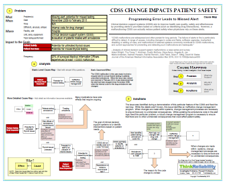Two workers were overwhelmed by hydrogen sulfide and later died of their injuries after attempting to fix a sewage leak at a waste water treatment plant in Wichita Falls, Texas on July 2, 2016. The city has released its internal investigation findings into the incident. In order to fully understand the issues associated with the incident, we can capture the information within a Cause Map, or visual form of root cause analysis.

The deaths of the two employees are an impact to the safety goal. The high levels of hydrogen sulfide are an impact to the environmental goal, while the need for a valve repair is an impact to the property goal. The emergency response and external incident investigation impact the labor goal. The investigation begins with one of the impacted goals as the first “effect” of a cause-and-effect relationship. Additional causes are added by asking “why” questions. Capturing all relevant cause-and-effect relationships offers the highest number of potential solutions, which can act on any cause to reduce the risk of a problem recurring.
The employee fatalities resulted from exposure to high levels of hydrogen sulfide. The high levels of hydrogen sulfide resulted from the leak of sewage with high levels of sulfur. While problems with ventilation can result in high gas levels, the intake and outgoing ventilation were both found to be functioning properly and the door to the building was left open. The sewage was contained in the pipes (as it was a waste water treatment plant) and leaked from a failed valve. However, the investigation found that the sulfur levels were higher than expected and set out to find the cause of the elevated sulfur. Industrial users of the waste water system have been interviewed and did not indicate any sulfur-using production processes or discharges with elevated sulfur. Although the investigation continues, the source of the elevated sulfur may never be determined. The proposed solution – installing permanent detectors in the basement and other areas of risk – will mitigate the risk of potential personnel injury due to high gas levels, regardless of the cause.
The exposure to high levels of hydrogen sulfide also resulted from the employees (both mechanics) being in the basement with the elevated hydrogen sulfide levels without self-containing breathing apparatuses (SCBAs). The employees were in the basement repairing the leak and initially entered wearing SCBAs, having been warned that the area smelled “gassy”. However, for reasons that are unclear the employees did not take air quality measurements or complete initial checklists for using SCBAs. A proposed solution is to require employees to carry gas detectors (which would provide immediate feedback as to whether an additional oxygen source was required) in areas where gas could be present. The investigation found that the training provided to these and other employees regarding the use of SCBAs was adequate and no changes to the program were recommended.
These potential solutions, which would provide real-time feedback as to gas exposure hazards, would increase the likelihood that employees would wear SCBAs or other personal protective equipment, thus reducing the risk of exposure to high levels of gas, when present. To view the outline, initial Cause Map and proposed solutions, please click on download PDF above. Or, click here to learn more.









